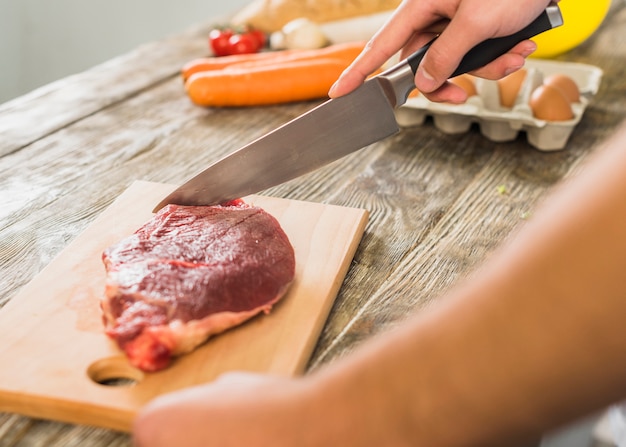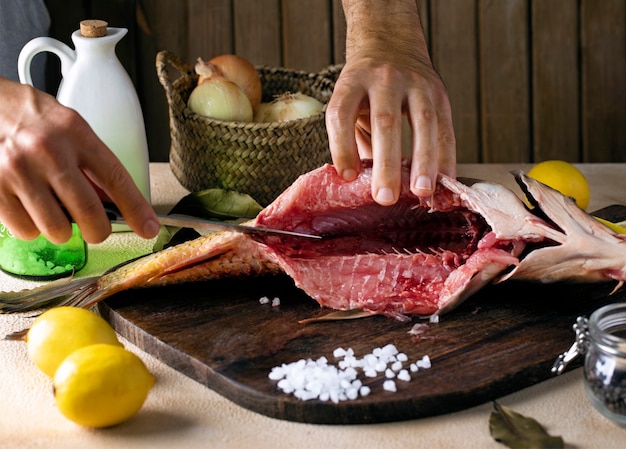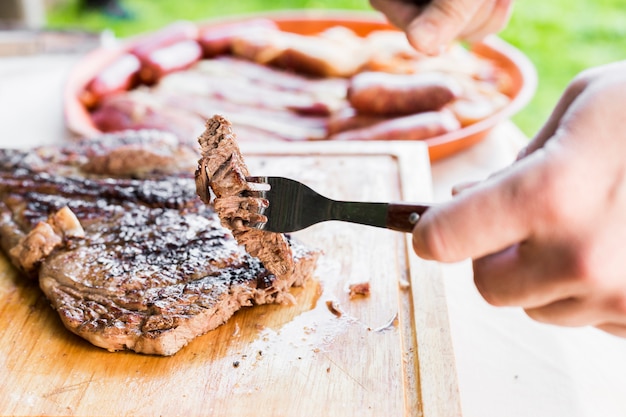Let's face it, there's nothing quite like a perfectly cooked T-bone steak. The juicy, flavourful meat, the satisfying sizzle on the grill, the satisfying "thunk" as you slice into it... pure culinary bliss! But let's be honest, mastering a T-bone can feel like a daunting task. It's a cut that deserves respect, and a misstep can lead to a dry, disappointing result.
But fear not, my friend! This guide is your roadmap to T-bone steak nirvana. We'll cover every step, from choosing the perfect cut to achieving the perfect sear and doneness. And don't worry, I'll be sharing my personal experiences and tips along the way, the ones that have helped me avoid dry steaks and achieve that melt-in-your-mouth perfection. Get ready to impress your friends and family with your newfound T-bone steak mastery!
(Part 1) Choosing Your T-Bone

The Cut That Makes All the Difference
The journey to a sensational T-bone begins with selecting the right cut of meat. Don't just grab the first one you see. Take your time and find a cut that's going to deliver the ultimate experience.
- Look for Marbling: The key to juicy and flavourful T-bone is marbling – those streaks of fat running through the meat. The more marbling, the more flavour and tenderness you'll get. Think of it as nature's built-in flavour enhancer!
- Grade Matters: You're looking for at least a Prime or Choice grade for a T-bone. These grades have more marbling, promising a richer, more satisfying eating experience. Don't be afraid to splurge a bit on a good cut; you'll definitely taste the difference!
- Thickness is Key: Aim for a steak that's at least 1.5 inches thick. This allows for even cooking and helps to keep the steak juicy, preventing it from drying out too quickly.
My Personal Choice: Grass-Fed or Grain-Fed?
Now, I'm a bit of a purist when it comes to beef. I personally prefer grass-fed T-bones. The flavour is more complex, with a richer, almost earthy taste. It's also a more sustainable option, which is always a bonus! But hey, grain-fed can be just as delicious, especially if you prefer a more buttery flavour. Ultimately, it boils down to personal preference.
(Part 2) Prepping for Perfection

The Art of Resting: Why it Matters
Before you even think about firing up the grill or pan, take your T-bone out of the fridge and let it sit at room temperature for at least 30 minutes. This allows the meat to come up to temperature evenly, ensuring a more consistent cook. Imagine it like this: if you throw a cold steak onto a hot grill, the outside will cook too quickly while the inside stays cold, resulting in uneven cooking. Resting helps to avoid this.
Seasoning Secrets: Simple is Best
Don't go overboard with the seasoning. A T-bone is a star on its own, so let its natural flavour shine. I use just a simple mix of salt and freshly ground black pepper. Trust me, it's more than enough to enhance the flavour.
I've experimented with all sorts of fancy rubs, but I always find myself coming back to the basics. If you really want to add something extra, you could try a pinch of smoked paprika or garlic powder, but don't overdo it! The goal is to complement, not overpower the beautiful flavour of the beef.
(Part 3) Grilling Your T-Bone to Glory

Alright, let's get grilling! This is where the fun really begins!
The Right Tools for the Job
Invest in a good quality grill. You don't need anything fancy, but make sure it's clean and preheated. I've been using a gas grill for years and it's worked wonders for me. But if you're more of a charcoal enthusiast, go for it! Just make sure the coals are white-hot before you put your steak on.
Grilling Like a Pro
- High Heat, Short Time: For a perfectly seared exterior and a juicy interior, you need high heat. Aim for a temperature of 450-500 degrees Fahrenheit. Don't be afraid of the flames; they'll help create a delicious crust and those coveted grill marks!
- The Sear: Start by searing the steak on each side for about 2-3 minutes per side. This will create a beautiful crust and lock in the juices, ensuring a flavorful and juicy steak.
- Rotate and Reduce: After searing, move the steak to a cooler part of the grill and reduce the heat slightly. You want to continue cooking the steak but without burning it.
- The Flip: Flip the steak only once to prevent drying out. Use tongs to gently flip it, ensuring a smooth and even sear.
- Don't Overcook: The most common mistake is overcooking a T-bone. Use a meat thermometer to ensure it reaches your desired temperature. For medium-rare, aim for 130-135 degrees Fahrenheit.
Resting Time: Let It Relax
Once your steak is cooked to your liking, take it off the grill and let it rest for at least 5-10 minutes before slicing. This allows the juices to redistribute throughout the steak, resulting in a more tender and flavourful cut. Think of it as giving your steak a chance to "relax" and recover from the heat.
(Part 4) Pan-Seared Perfection
Okay, so maybe you don’t have a grill, or it’s a bit too chilly for outdoor cooking. Don’t worry, you can still achieve a mouthwatering T-bone with a good pan.
The Right Pan Makes All the Difference
Invest in a cast iron skillet. It’s the best pan for searing steaks and achieving that beautiful crust. Cast iron retains heat incredibly well, ensuring a consistent and even sear. Make sure your pan is preheated over medium-high heat before you add the steak.
Mastering the Pan-Seared Technique
- High Heat, Hot Pan: Let the pan get really hot before you add the steak. This will ensure a nice sear, creating that crispy crust we all love.
- Sear It Well: Sear the steak on each side for 2-3 minutes to develop a flavorful crust.
- Reduce Heat, Cook Through: After searing, reduce the heat to medium and continue cooking the steak for about 5-7 minutes per side, depending on the thickness and your desired doneness.
- Flip It Once: Flip the steak only once to prevent moisture loss.
- Temperature Check: Use a meat thermometer to ensure your steak reaches your desired temperature.
Resting is Still Essential
Just like with grilling, it’s crucial to let your pan-seared T-bone rest for at least 5-10 minutes before slicing. This allows the juices to redistribute and prevent the steak from becoming dry and tough.
(Part 5) Reaching Peak Flavor: Sauces and Sides
Now, we're talking about finishing touches. A good sauce or a few well-chosen sides can elevate your T-bone from delicious to divine.
Sauce It Up
Don't get too fancy with sauces. A simple pan sauce made with butter, garlic, and herbs can be absolutely amazing.
- The Classic: Melt butter in the same pan you cooked the steak in. Add a clove of minced garlic, a sprig of rosemary, and a pinch of black pepper. Simmer for a few minutes until the butter is fragrant.
- The Bold: For a richer flavour, try adding a tablespoon of red wine to the pan sauce. Let it reduce slightly and then add your butter, garlic, and herbs.
side dishes that Shine
Keep your sides simple to complement the flavour of the T-bone. Here are a few of my favourites:
- Roasted Vegetables: roasted asparagus, broccoli, or Brussels sprouts offer a satisfyingly earthy flavour and a nice textural contrast to the steak.
- Creamy Mash: A classic for a reason, creamy mashed potatoes are a comforting and delicious side that pairs perfectly with the rich flavour of T-bone.
- Simple Salad: A fresh, simple salad with a light vinaigrette can help to cut through the richness of the steak and make the whole meal feel balanced.
(Part 6) Temperature Guide: How to Get It Right
One of the most important things when cooking a T-bone is getting the doneness right. You want to ensure it’s cooked to your liking, whether you prefer rare, medium-rare, medium, or well-done. Here’s a table to guide you.
| Doneness | internal temperature (°F) | Description |
|---|---|---|
| Rare | 125-130 | Center is cool, red, and very juicy |
| Medium-Rare | 130-135 | Center is warm, pink, and juicy |
| Medium | 140-145 | Center is warm, slightly pink, and less juicy |
| Medium-Well | 150-155 | Center is warm, light brown, and not very juicy |
| Well-Done | 160 | Center is hot, brown, and dry |
(Part 7) T-Bone steak mistakes to Avoid
We all make mistakes, but when it comes to T-bone steak, there are some common pitfalls you can avoid.
- Overcrowding the Grill/Pan: This can cause the steak to steam instead of sear, resulting in a lackluster crust and uneven cooking. Give your steak some space!
- Poking and Prodding: Resist the urge to poke or prod the steak while it’s cooking. This can release valuable juices and make it dry. Let the steak cook undisturbed, it'll reward you with a more tender result!
- Skipping the Rest: Don't skip the resting period. It’s crucial for letting the juices redistribute, preventing a dry and tough steak.
- Over-Seasoning: A T-bone is flavourful on its own. Keep the seasoning simple. Let the natural beef flavour shine through.
(Part 8) FAQs: Your T-Bone Steak Questions Answered
1. Can I cook a T-bone steak from frozen?
It's not ideal. Frozen meat can be tough and unevenly cooked. Always thaw your T-bone in the refrigerator for 24 hours before cooking. This ensures a more consistent cook and a juicier, more flavorful steak.
2. How do I know when a T-bone is done?
The best way is to use a meat thermometer. Refer to the temperature guide in Part 6 to ensure your steak reaches your desired doneness.
You can also check for doneness by gently pressing the steak. If it feels springy, it's rare. If it feels firm but gives slightly, it's medium-rare. If it feels firm, it's medium. This is a good way to gauge doneness if you don't have a thermometer handy.
3. Can I use a marinade on a T-bone steak?
It’s possible, but I usually prefer to keep it simple. If you do marinade, make sure to pat the steak dry before cooking to prevent steaming. This will ensure a good sear and prevent the marinade from making the steak too wet.
4. What if I overcook my T-bone steak?
Unfortunately, there’s not much you can do to salvage an overcooked steak. It will be dry and tough. The best thing is to learn from your mistakes and make sure you don’t overcook it next time.
5. What are the best cuts of meat for grilling?
Beyond the T-bone, other great grilling cuts include ribeye, new york strip, sirloin, and flank steak. Just be sure to choose cuts with good marbling and thickness for the best results.
There you have it, my friend. Your ultimate guide to T-bone steak mastery. Now go forth and cook yourself a masterpiece! And remember, the most important thing is to have fun and enjoy the process. Happy grilling!
Everyone is watching

Corn on the Cob: The Ultimate Guide to Perfectly Cooked Ears
Healthy MealsAh, corn on the cob. Just the name evokes images of sunny days, barbecues, and that sweet, juicy flavour that ...

Perfect Pork Roast Oven Cooking Time: A Guide to Delicious Results
Healthy MealsThere's something truly satisfying about a perfectly roasted pork. The aroma alone is enough to make your mout...

Ham Cooking Time: How Long to Bake, Smoke, or Boil a Delicious Ham
Healthy MealsAh, ham. It's a classic, isn't it? A real crowd-pleaser, especially around holidays. And when done right, it'...

Scallops: The Ultimate Guide to Perfect Cooking
Healthy MealsAh, scallops. Those delicate, sweet, and utterly delicious morsels of the sea. They hold a special place in my...

Spaghetti Squash: The Ultimate Guide to Cooking and Serving
Healthy MealsRemember that time you saw spaghetti squash at the supermarket, looking all bumpy and strange, and thought, "W...
